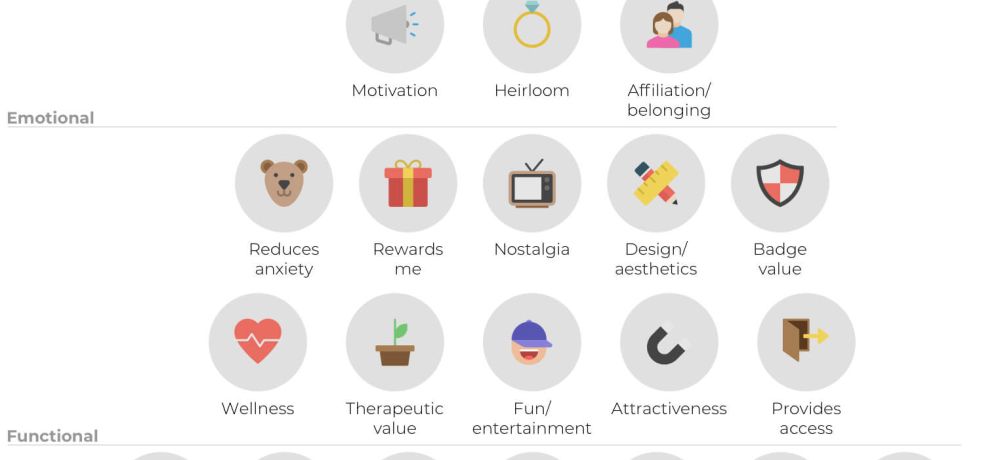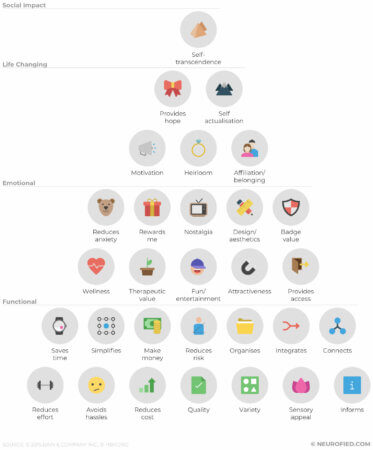
Improve your brand’s worth with the pyramid of value
As a consumer, what are your go-to brands? What do you like about them? Now think of your brand. What do your customers love about it? What gives it an edge over your competitors? These factors determine the value of your brand. Improve it with the pyramid of value.
The perceived value of your company is vital to its success. When customers consider buying your product, they ask themselves one fundamental question. Is it worth the money? To make their decision, they weigh the price of the product against the perceived value of the product. Most companies tend to focus on the pricing end of the equation. Prices are tangible and easy to modulate and measure.
In contrast, psychological factors determine the perceived value of a product. Thus, it is harder to grasp. In this article, we explore the elements that define perceived value. We also explain how to harness their marketing power.
The elements of value
Understanding the things that customers value helps in building a successful brand. However, what is considered valuable? A comprehensive marketing study has explored this exact question. Bain & Company collected loads of customer reviews and derived a set of 30 elements of value. The elements fall into four categories:
- Functional;
- Emotional;
- Life changing;
- Social impact.
Let’s explore these four categories to get a better understanding of them.
Functional
In this category, we find 14 elements that add to the functional and practical nature of a product. One example is the time-saving element. Some companies score high on this element by offering a rush delivery service.
Emotional
The ten elements belonging to this category have effects on customers’ feelings. They induce positive emotions or prevent a negative state. Take nostalgia, for instance. The Volkswagen Beetle line is an example of successful use of this element.
Life-changing
The five elements in this category help customers achieve goals, such as health, status and motivation. Spotify taps into the motivation element with a feature for runners. It detects a runner’s tempo and finds music to match it.
Social impact
The only and influential element in this category is self-transcendence. It is all about making the world a better place. One company that implements this is TOMS. This company donates some of their products and profit to developing countries.
Applying the Pyramid of Value
All of these elements nicely stack to form a pyramid. Moreover, that is no coincidence. The idea that there is a hierarchy of needs has deep roots in psychology (Maslow’s hierarchy of needs). The higher you go up the pyramid, the more value you’ll find in the elements. So the top-most element (self-transcendence) is the most powerful. However, don’t be too fixated on those top tiers! Offering a great product is not about fulfilling the most complex consumer needs. It’s about providing a powerful combination of needs. With the Pyramid of value, you have a tool to test the value of your brand. However, before you go and do that, take note of these four basic rules.
1. More is better
It’s great if your company excels in something. Make it your slogan! However, also be sure to put the effort in extra elements of value. Scoring well on multiple elements in the pyramid is a recipe for success. The more elements companies deliver, the higher their loyalty and revenues soar. However, rest assured, your brand does not need to cover the full spectrum of perceived value. Even Apple, one of the companies that deliver the most amount of value, scores high on only 11 elements.
2. Find the elements that are relevant
A pattern of elements that works great for one type of product might not give the same results for another. For example, organizing and connecting are essential elements of the smartphone industry. However, these elements don’t play a central role in the clothing industry. The latter focuses more on offering variety and aesthetics. Another essential element of the clothing industry is avoiding hassles. Think of free shipping and a straightforward return policy. To make a great product, you need to understand the pattern of value for the specific product niche.
3. Create a solid basis of functional elements
Let’s continue with the example of the smartphone and clothing industries. If you look up the elements mentioned before, you’ll notice that most of these are functional. In other words, the lowest tier of the pyramid is the most important. The five most essential elements in the smartphone industry are all functional in nature. These are quality, reducing effort, variety, organizing and connecting. So none of the shiny higher-order elements! Good products have a solid basis of functional elements. This also makes sense from the perspective of the good old pyramid of needs by Maslow. First, you should have your basic biological needs covered. Only then can you aim for more complex needs.
4. There’s no substitute for good quality
We mentioned that different product niches have different patterns of value. However, there is one element that all industries have in common. For each sector, the most critical customer needs to fulfill is quality. If there’s a significant shortfall on product quality, no other element can make up for it!
Measuring the perceived value of your product
Now that we’ve covered the theory let’s move on to the practical part. How do you get a measurement of perceived value that you can work with to grow your brand?
Perceived value is all in the eyes of the beholder: your customers. So the best way is to ask them! Collect reviews and ratings and see how your brand and products perform on relevant elements. Find the gaps that competitors might try to exploit and discover the elements that will form the basis for your next fantastic product.
Are you wondering which elements of value should be central to your brand? Want to find out how to harness that knowledge? Get in touch and learn about our tailored services. Let’s make your brand more valuable and make your business grow.
Brain & Behaviour Course
Another way to really know what is valuable for your customers is by looking into their brain and corresponding behavior. Find out what makes them tick and how you can turn this into key strategies for your business. Check out our free Brain & Behaviour Course here!
Sources
- https://hbr.org/2016/09/the-elements-of-value
- https://simplypsychology.org/maslow.html
- http://www.bain.com/bainweb/media/interactive/elements-of-value/
If you want to learn more about behavioral insights, read our blog or watch 100+ videos on our YouTube channel!
About Neurofied
Neurofied is a behavioral science company specialized in training, consulting, and change management. We help organizations drive evidence-based and human-centric change with insights and interventions from behavioral psychology and neuroscience. Consider us your behavioral business partner who helps you build behavioral change capabilities internally.
Since 2018, we have trained thousands of professionals and worked with over 100 management, HR, growth, and innovation teams of organizations such as Johnson & Johnson, KPMG, Deloitte, Novo Nordisk, ABN AMRO, and the Dutch government. We are also frequent speakers at universities and conferences.
Our mission is to democratize the value of behavioral science for teams and organizations. If you see any opportunities to collaborate, please contact us here.

